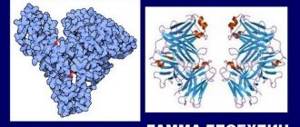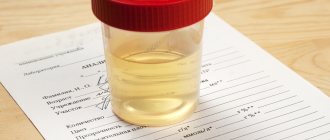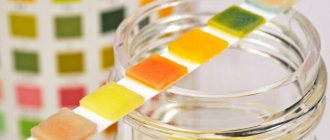Laboratory diagnostics is an integral part of a doctor’s daily work. Test results are sometimes the key to making a diagnosis. General clinical tests should be taken regularly even by healthy people, as they help identify disorders in the early stages. But even the most modern laboratory will not be able to correctly evaluate material for analysis that was collected and delivered in violation of the requirements.
There are several different laboratory tests that provide the necessary information about the characteristics of urine.
Laboratory tests for urine examination:
- general urine analysis,
- analysis according to Nechiporenko,
- analysis of daily urine volume,
- Zimnitsky's test,
- bacteriological culture,
- PCR diagnostics,
Each analysis is characterized by the characteristics of collecting the necessary material. It is very important to adhere to all conditions and requirements, since any, even the most harmless violation, can distort test results.
Urine is a test material for diagnosing various diseases. Depending on the suspected disease, the doctor prescribes the necessary laboratory test.
Diseases for which I definitely prescribe urine tests:
- kidney disease,
- cystitis,
- prostatitis,
- urolithiasis disease,
- gynecological diseases,
- diabetes,
- heart diseases,
- infectious diseases,
- sexually transmitted diseases,
How to store urine until it is sent to the laboratory
Urine is a perishable product because it consists of a large amount of organic and inorganic substances that break down into simple components.
Some of them react with each other, which negatively affects the composition of the liquid. Irreversible changes begin to occur after a few hours. As a result, the biomaterial becomes unsuitable for analysis, and its indicators become uninformative.
There are certain requirements for urine collected for analysis. The main one is collecting material in the morning after waking up. But sometimes, due to circumstances or the inability to quickly get to the laboratory, it becomes necessary to preserve the biofluid for several hours.
Storage of urine that was excreted in the morning is allowed at room temperature for a couple of hours. Long-term maintenance of the biomaterial prepared for research causes changes in its basic characteristics. Urine collected for research using the following methods cannot be refrigerated.
General analysis. Available in the morning. Delivery is required within an hour.
Nechiporenko test. The collection is carried out immediately after waking up and is stored for no more than 60 minutes.
In a refrigerator
The best option is to keep the collected sample in a cool place. For this purpose, experts recommend using a refrigerator. At a temperature of 3...4°C, urine can be stored for several hours. It should be remembered that greater cooling can provoke the formation of insoluble sediment, and an increase can lead to the formation of a decomposition reaction of organic substances.
It is important to know! The exception is the Zimnitsky test. For him, keeping the urinary fluid in a cool place is allowed for 24 hours, after which he must be transported to a medical facility. It is permissible to send liquid intended for daily sugar analysis into the refrigerator.
For the reliability of some tests, it is necessary to give urine an hour after collection. In other cases, urine is stored for several hours - this is due to the technology of collecting material for research.
According to Zimnitsky
To perform the analysis, you will need to write into a separate jar every three hours during the day. The results of urine collection from a child or adult should be stored in the refrigerator. The analysis is carried out no later than 4 hours after the last sample is collected.
General clinical
This test is most often prescribed during regular medical examinations. Its results are not suitable for making an accurate diagnosis, but will help identify problems with certain organs.
The most difficult thing is to collect biomaterial from a baby - you will have to use special urinals. Adults will need to collect an average portion of morning urine in a sterile container, after washing the genitals.
Urine must be delivered for analysis a maximum of 4 hours after collection.
According to Nechiporenko
A specific analysis that detects pyelonephritis, urethritis, and other inflammations of the urinary tract in an adult or child. The collection of material is carried out in the same way as for general analysis, and the shelf life of urine for research is two hours.
The analysis reveals the presence of blood components in urine; it can also be used to determine the number of cylinders (particles of the renal epithelium). It is prescribed to patients undergoing treatment for kidney and urinary tract diseases in order to determine the effectiveness of therapy.
Urine is collected throughout the day. You need to store it in the refrigerator and use a special sterile container for collection. The shelf life of urine after collecting the last portion of urine is 1-2 hours.
Three-glass sample
This test requires three sterile containers. When emptying the bladder, fill them one by one and note which of them contains the initial, middle and final portions of the biomaterial. How long such urine is useful depends on storage conditions. Most often it is 1-2 hours.
For diastase
Diastase is an enzyme that breaks down starch. Its amount in the urine indicates whether there is inflammation of the pancreas or not. For analysis, a small amount of morning urine is needed (a few milliliters is enough).
Due to the rapid destruction of the enzyme, it is necessary to submit urine to the laboratory a maximum of an hour after collection.
For bacterial sowing
This analysis identifies harmful microflora in the urine, and also determines its quantity and type. The shelf life of urine for testing is 2 hours. The collection is carried out very carefully: the genitals are washed and dried. Before urinating, women part their labia; men expose the head of their penis. If you do not comply with the requirements, the results will be false, since bacteria will enter the urine from the skin and mucous membranes.
Daily urine
Urine is collected in a sterile container throughout the day. Such urine is needed for several laboratory tests. Its shelf life can be artificially extended using special preservatives. Before donation, urine must be stored in a refrigerated unit to prevent the decomposition of some enzymes.
For sugar
For glucose tests, 24-hour urine is used. It must be submitted to the laboratory within 2 hours after collecting the last portion. You can extend the storage of biomaterial using cold and preservatives.
Rehberg's test
Determines the rate of fluid secretion by the kidneys and is used to diagnose tissue lesions. A portion of daily urine (50 ml) is taken for analysis. When submitting to the laboratory, it is necessary to indicate the total volume of liquid excreted per day, accurate to half a glass. Urine stored at room temperature and not in the refrigerator is not suitable for research.
The reliability of the research depends on the correct collection and storage of urine. At room temperature, pathogenic microflora multiply in the biomaterial, many enzymes disintegrate, and the elements react, forming new compounds. If measures are not taken to preserve urine, the tests will have to be repeated.
Before collecting biomaterial, be sure to wash your hands and wash your genitals. Analysis must be collected in clean containers. For a baby, you can purchase a urinal bag - a container with a special hole and Velcro for fastening to the body.
Low temperature and preservatives help preserve urine.
You can store the collected urine in the refrigerator until the morning. Recommended storage temperature is 4-8°C. In domestic refrigerators it is supported on the door and bottom shelf. The shelf life is no more than 12 hours.
Preservatives
The doctor can tell you how to store urine for daily testing so that it does not lose its properties. Storage in the refrigerator loses its effectiveness, because the material must be collected within 24 hours. You can solve the problem by adding to urine:
- 5 ml of acetic acid for the entire volume of liquid;
- 2 ml of toluene for the entire jar of biomaterial;
- boric acid at the rate of 10 granules per glass;
- thymol – 2 crystals per 100 ml of liquid.
How do you know when your urine is bad?
If stored for a long time without refrigeration, urine analysis, like organic matter, becomes unusable. Microbes multiply in it, glucose drops, and the liquid oxidizes. If the collected material has sediment, or the urine has become cloudy or was collected in the evening, then the conclusions will be uninformative. The mixture sometimes becomes cloudy if it sits in the refrigerator.
This is due to the presence of salts in the urine. If it becomes cloudy under natural conditions, then the biomaterials must be delivered immediately after collection. Thus, cloudy urine becomes evidence of the disease. If it turns out that the analysis was carried out in violation of the standards for preserving and transporting the substance, the patient will need to repeat the procedure.
Accurate result
The exact result is shown only by the analysis for which the material is fresh. For this reason, it is necessary to minimize the time between collecting material and submitting it for analysis. Only in this way will the reliability and quality of the results be as accurate as possible.
So, how long can you store urine for analysis?
Although no preparation is required for this test, it is most optimal to take it in a hospital setting. The main limitation is the amount of liquid consumed; it should be as little as possible. On the eve of the test, you must follow a predominantly meat diet.
Urine is collected throughout the day. However, in practice this is quite difficult to implement, since it must be stored correctly. Therefore, the express method of collection within 12 hours is increasingly being used. Urine is collected before bedtime and then in the morning. After which it is mixed and poured into a container, which is taken to the laboratory.
The results of medical research, in other words, analyses, are documents of legal significance (the exact definition is given in Article 1 of Law No. 77-FZ of December 24, 1994 “On the Legal Deposit of Documents”).
The tests are attached to the patient’s medical record, which must be stored for 5 years. This period is regulated by the List of standard documents dated August 15, 1988.
Test results that the patient did not come for or those that remained unattached to the cards are considered unclaimed. As a rule, they are not kept in the clinic for more than one month and are thrown away as irrelevant.
There are often cases when a patient is informed that his tests are invalid: they are already expired and new, fresh ones are needed. Sometimes this causes outrage and disagreement. However, knowing about the expiration dates of examination results, you can avoid conflict situations, protect your nervous system and achieve proper treatment.
If you find an error, please highlight a piece of text and press Ctrl Enter.
To solve your problem, get a free LEGAL consultation RIGHT NOW:
7 Moscow 7 (812) 467-38-65 St. Petersburg
How to please laboratory assistants?
Before finding out how many milliliters of urine are needed to test a baby, you need to clarify what type of test for this biological fluid is assigned to your child. Once you have answered this question, try to collect the following quantity:
- biochemical (general) urine analysis – 20 ml;
- analysis according to Nechiporenko - 15-20 ml of average urine (collected in the morning in the middle of urination);
- Zimnitsky analysis - all the contents of the bladder released during the day;
- culture - 15 ml of average urine;
- Sulkovich test (for calcium) - all urine collected on an empty stomach.
Not all mothers are able to meet the standard laboratory requirements. It happens that you manage to collect literally 1 tsp. urine, that is, no more than 10 ml. What should you do - put off the analysis for a few days, hoping that tomorrow you will have better luck? Don't rush to write yourself down as a failure. Doctors can take a container filled to just 1 cm - that's about 10 ml. For analysis according to Nechiporenko, even less than 1 tsp is enough. urine.
Most often, doctors are sympathetic to the difficulties of parents. But it happens that laboratory staff clearly state how many ml of urine is needed to analyze a baby, and refuse to examine the liquid if their recommendations are not taken into account.
The norm for conducting a urine test for children under one year of age is considered to be a portion of 20-30 ml. This amount of material is enough for a general analysis of a baby’s urine; the same amount is needed for other types of research, except for the Zimnitsky and Sulkovich tests, when all urine should be collected over a certain period of time.
Do shelf life depend on the type of analysis?
Most people associate taking a urine test with collecting material in the morning and sending it for diagnostics. In reality, there are many other types of laboratory testing of urine, and for each of them there are certain rules for its preparation, as well as optimal storage periods.
General analysis
This type of research is carried out to determine the visual properties, chemical composition, and study of sediment. You need to donate an average portion of urine collected in the morning. The most accurate results can be obtained based only on fresh material. In exceptional situations, urine can be stored for no more than two hours at a temperature of 2-4°C.
The method is aimed at identifying the degree of functionality of the renal apparatus. It involves collecting urine in portions over 24 hours. To do this, you will need to prepare eight sterile containers of sufficient capacity so that each of them fits the full volume of the isolated liquid. All jars must be numbered and, after filling, stored in the refrigerator. The maximum holding period is 24 hours.
Allows you to determine the presence of diseases such as cystitis and pyelonephritis. Urine intended for research can be stored for an hour. This minimum period is due to the rapid proliferation of bacteria, which can affect the final result of the analysis. The material should be delivered to the laboratory immediately after collection.
This option is prescribed relatively rarely, however, it allows us to identify the development of dangerous pathologies of the genitourinary area. The material is collected in a three-liter jar within 24 hours, and during this time it must be stored in a cool place. Sometimes it is recommended to add a drop of formalin to it in order to preserve the urinary fluid. Only a small part is sent to the laboratory - approximately 50-100 ml.
Three-glass sample
The analysis helps determine the development of inflammation, while simultaneously clarifying the data obtained during OAM and the Nechiporenko test. Urine must be obtained in one urination and distributed into three clean containers. The material can be stored indoors for no longer than two hours. In a cool place this period can be extended to 24 hours. The optimal microclimate is plus 5°C.
Advice! When sending urine for storage, it should be remembered that keeping the material for more than 24 hours, especially in room conditions, distorts the result of the analysis and requires it to be repeated. Frozen urine cannot be examined either.
How to collect urine from a baby girl and boy?
Special urinal
A urine bag is a device for collecting urine. This simple device is essentially a sterile plastic bag with an anatomical cutout. There is Velcro around the opening of the urinal, with which the device is easily glued to the skin of the perineum. This design prevents liquid leakage and slipping.
When using a urinal bag correctly, the possibility of microorganisms from the external environment entering the urine is completely eliminated. The result of the analysis will be as reliable as possible.
There are universal urine bags that can be used by boys and girls. But it is better to choose a variation adapted for everyone.
How to collect urine from a girl using a urine bag?
The urinal designed for girls has an oval shape.
What should parents do to attach a urine bag?
- Wash your hands thoroughly with soap, wash and dry the child with a disposable towel.
- Place the girl on her back, spread her legs.
- Remove the protective covering from the Velcro of the urine bag.
- Position the opening of the reservoir against the labia majora so that the anus is out of the urine collection area.
- Once you are sure of the correct placement, press down the adhesive outline with a light movement.
- It is allowed to put on a diaper or fix the desired position of the urinal with a diaper.
- It is better to hold the baby in your arms during the test collection procedure to prevent displacement.
- Keep an eye on the tank filling. Thanks to the markings on the plastic bag, you can easily control the amount of liquid.
- Carefully remove the device and pour the test urine into a special container.
Fridge
To extend the shelf life of urine, it can be placed in the refrigerator door. However, under no circumstances should the material be allowed to freeze. But cooling, although it does not affect the main components, can change the density of the liquid itself. Regardless of how long the collected urine was stored in the refrigerator, this should be reported to the laboratory employee or this fact should be noted in the direction. Before the study, you need to determine exactly how long urine can be stored for analysis.
Tricks of experienced mothers, or how to easily collect urine from a baby?
It all depends on the age of the baby. The psychophysical development of a newborn and a one-year-old child is very different. You can try to “agree” with a one-year-old toddler, explain or play out the situation in a playful way.
When collecting urine from a newborn, one must be guided by knowledge of the physiological characteristics of children at this age.
How to collect urine from a newborn girl easily and quickly?
- Usually children at this age pee immediately after waking up, during or after feeding;
- to collect morning urine, you must not miss the moment when the baby wakes up;
- you need to unfasten the diaper and immediately glue the urinal;
- you can try to collect urine using a sterile plate, but this is more difficult;
- If the baby is unable to do her business, take the child in your arms, take her to the bathroom and turn on the water. The sound of rushing water will speed up urination;
- Perform a light massage on the abdomen, in the bladder area, or place a napkin moistened with warm water on the lower abdomen.
The same recommendations will help to collect urine from a three-month-old baby who does not yet know how to sit.
How to collect urine from a newborn boy?
Doctors recommend collecting an average portion of urine for accurate analysis. If for girls it is very difficult to collect an average portion, then for boys it will be possible if you put in some effort:
- Immediately after the boy wakes up, keep a container ready to collect urine. Try to “catch” the stream of urine with the container;
- If this method seems too complicated for you, don't despair. A urine bag will help collect the entire portion of morning urine. For children's analysis this is acceptable.
How to collect urine from a one-year-old girl?
Often babies from 9 months to a year know what a potty is and agree to sit on it after waking up. If this is a normal procedure for a girl, simply place a sterile enamel plate in the pot. When the baby finishes her business, carefully pour the contents of the plate into a special container.
You cannot take urine for analysis from the pot. No amount of cleaning agents or dousing with boiling water will make the pot sterile!
If the baby is not yet familiar with the potty, immediately after waking up, while the baby is lying down, place a sterile plate under the butt, massage the tummy and wait. Do not forget to put an oilcloth or diaper on the bed to prevent liquid leakage and not to wet the bed.
Collecting urine from a baby boy is a little easier. The structure of the genital organs of a toddler allows you to use any sterile container and collect even an average portion of urine. You just need to show a little patience and skill.
Regardless of the gender of the child, speak kindly and calm the little one, recite a poem or give the child a book or toy. Be confident in your actions, the baby will feel it.
Features of collection and storage in children
Collecting urine from older children is not difficult, since it is performed in accordance with the recommendations of doctors for adult patients.
- Prepare a sterile container or glass jar.
- Lift the child out of bed, wash the external genitalia with warm water and a neutral detergent.
- Wipe the urogenital area dry with a towel or napkin.
- Make him sit on the toilet and force him to release a small amount of urine.
- Place the container near the urethra and repeat the process.
- Flush the rest of the urine into the toilet.
It is much more difficult to collect material for research in a child under one year old, since he begins to urinate immediately after undressing. Therefore, you need to prepare the container in advance. This could be a test tube, jar, container or deep saucer.
Doctors do not recommend draining the resulting urine from the pot or squeezing it out of a diaper or diaper. This may lead to infection with bacteria, which will affect the reliability of the results. Here are some options for proper collection.
How to properly wash a child?
The girl needs to be washed so that warm, clean water flows from front to back. This is necessary to prevent microorganisms from the perianal zone from entering the girl’s genital tract.
You can wash the boy in a position convenient for you. If the head of the penis is closed, there is no need to touch it so as not to injure it. If there is no phimosis, the glans is open, you need to wash the head of the penis.
Failure to follow simple rules for collecting urine will lead to incorrect results. Even a doctor will find it difficult to determine why the indicators have changed. Proper treatment in such a situation is out of the question.
Preservatives
If the doctor orders the collection of daily urine, then it will be necessary to add one of the preservatives presented below to the first portion of urine. The main drugs for this purpose are:
- "Thymol". Several crystals of the drug per 100 ml of urine.
- "Toluene". A few milliliters of the drug are dripped into a container with urine. A film appears on the surface of the urine. This product has bacteriostatic properties and does not interfere with the study, but it may make the urine slightly cloudy.
- "Boric acid". 3-4 granules added to 100 ml of urine also create a bacteriostatic effect.
- Heavily chilled acetic acid. It is necessary to add 5 ml for the entire daily portion of urine.
How long can you store before taking a urine test with preservatives?
In this way, it is possible to preserve the properties of urine for research and obtain the most accurate result. Below we will look at the characteristic features of urine collection and delivery, depending on the type of analysis prescribed.
Sulkowicz Study
The Sulkovich test is a urine test for calcium content. Today, this analysis is very often prescribed to young children. If deviations are not detected in time, problems with the kidneys, gastrointestinal tract and nervous system can be caused.
The Sulkovich study is prescribed according to the following indications from the attending physician:
- the child consumed a lot of vitamin D and A;
- There is a suspicion of hyperthyroidism or sarcoidosis.
To give your baby’s urine a Sulkovich test, you need to collect 20-25 ml of liquid in the morning before meals in a sterilized container. At the same time, pay attention to whether there is sediment in the urine and what color it is.
General urine analysis
A general blood test is the most common and informative method of diagnostic research for therapeutic, surgical, pediatric, and gynecological diseases. It allows you to assess your health and identify possible pathological changes. Thanks to it, it is possible to identify serious diseases in the early stages and prevent their further development.
It contains indicators about blood cells - red blood cells, platelets, leukocytes, coagulability, hemoglobin, ESR. The main diseases that are immediately visible when looking at the indicators are hematological, inflammatory, and infectious.
Basic rules when donating blood
- Blood is donated on an empty stomach - before the test you must abstain from eating for at least 8 hours.
- Avoid smoking, drinking beer and other alcohol-containing drinks 10-12 hours before.
- Avoid taking medications if possible.
- Limit fatty and fried foods in your diet for 2-3 days.
- It is advisable not to donate blood after an x-ray or physical therapy.
The validity period of a general blood test is from 10 to 14 days.
It is necessary to meet these deadlines, because laboratory indicators correspond to the clinical picture of the disease. And when the doctor examines the skin for the presence of an allergic rash, he will check the general blood test, which will show a high percentage of eosinophils. And with pneumonia or bronchitis against the background of wheezing in the chest, the results will be an increased ESR, leukocytosis, a shift of the leukocyte formula to the left, an increase in the level of neutrophils in case of a bacterial infection and an increase in the number of lymphocytes in case of a viral infection.
As the disease progresses, new symptoms appear, existing ones go away or become more pronounced, and all this is reflected in the tests that the doctor reads. That's why the more recent your results, the more consistent they are with your current clinical picture.
General urine analysis is the main and widespread method of laboratory diagnosis of health conditions. It is prescribed during preventive examinations to all adults, elderly people, and pregnant women and children according to a specific schedule. It is the first step in examining patients with suspected kidney and urinary system disease. A laboratory assistant studies the physical and chemical properties of urinary fluid.
Based on this analysis, one can judge the presence of pathological changes in the body; it reflects not only the functioning of the kidneys, but also the health of other internal organs. For example, with pneumonia, slight proteinuria and microhematuria may be detected in the urine, which does not occur normally. And immediately after recovery, all these changes disappear.
The period during which a general urine test is valid is 10-14 days. In order for it to be informative and reliably show the state of the body, a number of small conditions must be met before taking the test. Then it will reflect the internal picture of the ongoing processes as accurately as possible, and there will be no need to retake the urine to clarify the indicators.
How to prepare for urine collection:
- 3 days before the test, you need to exclude from food spicy and fatty foods, smoked foods, foods that can color urine - beets, rhubarb, blackberries;
- you should not take vitamins and dietary supplements;
- you cannot drink coffee, beer and alcohol-containing drinks;
- It is advisable to exclude intense physical activity;
- It is better to reschedule a visit to the bathhouse and sauna for several days;
- It is better not to donate urine during menstruation, as it is possible that menstrual blood may enter;
- It is not recommended to conduct research after catheterization or cystoscopy for 5 days.
Urine collection:
- the sample requires morning urine collected after sleep;
- before getting ready, you need to take a shower and thoroughly wash your genitals;
- The container must be sterile and dry, without traces of soap, detergent or soda. It is better to use disposable containers purchased at the pharmacy;
- the sample requires about 100 ml of urine;
- the collected liquid must be delivered to the laboratory within the next 2 hours; it must be stored in a cool, dark place, preferably in the refrigerator.
It will also be useful to know the validity periods of other tests:
- blood sugar test 10-14 days;
- biochemical blood test 10-14 days;
- blood for AIDS 6 months;
- blood for syphilis 3 months;
- blood for markers of hepatitis B and C 3 months.
In order for a visit to a doctor to be informative and not in vain, you need to prepare for it in advance - take a general blood and urine test, as well as other recommended tests. It is important to know the time during which the results are considered valid, so as not to come to an appointment with a specialist with expired results that have lost their relevance. Therefore, if you are undergoing an examination, try to get tested as soon as possible and immediately get an appointment with a doctor with the results.
How long can you store? This study involves collecting urine from the morning portion, that is, that which has accumulated in the bladder during the night. It is during this period that natural fluctuations in physical and chemical parameters in the body are at a minimum level. Therefore, it is possible to determine with maximum accuracy the pathological changes occurring in the human body.
How to properly collect urine from a girl or boy?
There are general rules for successful urine collection:
- You need to collect urine for general analysis in the morning. The composition of urine changes throughout the day. There are daily fluctuations in the composition associated with the phases of the child’s activity, fluid intake and food during the day;
- it is necessary to properly wash the child;
- it is important to use a sterile container for collecting urine;
- the analysis must be delivered to the laboratory quickly. It is unacceptable to store collected urine for more than 3 hours;
- It is better to store research material on the refrigerator door. Storing in a bright, warm or too cold place will distort the result.
Urine analysis according to Zimnitsky
This study involves collecting material from 8 portions of urine over 24 hours. To collect the material you will need 8 special cups. Full name must be indicated on containers. patient and numbered from 1 to 8, as well as the time of collection of each portion. The very first morning portion is not taken for analysis. From 9 a.m. every three hours it is necessary to empty the bladder and collect material. The final portion is collected from 6 to 9 am the next day.
Since the patient may experience additional urges to go to the toilet between the specified times, this fluid also collects. Do not allow even a small amount of urine to be poured into the toilet. If one of the cans is overfilled, then you need to take additional containers. If the urge to empty the bladder does not occur at the specified time, an empty jar is sent to the laboratory.
It is important to check with the medical staff how long you can store urine for analysis.
In order to correctly decipher the results of the study, the doctor needs to have additional information about the amount of fluid the patient drinks per day. Storage conditions for collected urine are also an important point. It is necessary to keep containers in the refrigerator door. The most important thing is to prevent the material from freezing.
How to understand test results
When parents receive the test result of their child, its decoding raises a huge number of questions. To understand them, you need to know what the norm and deviation of certain indicators are.
Decoding the analysis: deviation and norm
- First of all, we pay attention to the color and transparency of the urine. There should be no sediment in the form of beer flakes. It should be transparent and light yellow in color.
- Ph is an indicator of the environment. Small children who are breastfed have a slightly alkaline environment. When complementary foods are introduced into the diet, the environment will eventually become slightly acidic.
- Specific gravity of urine. This indicator indicates the amount of substances that are dissolved in children's urine. At an early age, the norm is from 1008 to 1020. The specific gravity of urine collected in the morning before meals is slightly higher.
- There should be no protein in children's urine.
- Leukocytes. For boys, the norm is from 2 to 4, for girls – from 4 to 6. It is worth noting that the result of an analysis of a healthy child will show an almost complete absence of leukocytes. If a small amount is found, most likely the parents did not wash the baby well or did not sterilize the container before collecting urine.
- Detection of phosphate salts is a cause for alarm. More often, this result is a warning of kidney problems.
If the overall result of the baby’s analysis reveals abnormalities, you will have to take it again or resort to additional studies (bacterial culture, according to Sulkovich). To obtain reliable information, check with your doctor about how much urine (ml) you need to collect again and how to do it correctly. It is important that parents do not have any questions. If the interpretation of any indicator is not clear, ask your doctor to explain everything to you.
Three-glass sample
It is strictly forbidden to transfer biological fluid from one container to another. How long is urine stored for analysis of a three-glass sample? The biomaterial is valid for microscopy only if it is stored for no more than 60 minutes at room temperature.
To conduct this type of analysis, you need to collect a morning portion of urine on an empty stomach. Before collecting material, hygiene procedures must be carried out. Urination is divided into three stages. The middle portion should be the largest. Containers must be labeled with numbers from 1 to 3. How long can urine be stored for analysis? Storage of urine for this type of analysis should also not exceed two hours.
Children's question
The procedures and timing described above are intended for adults. But how to properly collect and store a child’s biomaterial, are there any differences?
It is recommended to take tests in portions of 100-150 ml. For an adult, obtaining such a volume is not difficult, but collecting material from a newborn sometimes turns into a whole problem. Special children's urine collectors, which are sold in every pharmacy, come to the aid of young parents. The design of the device is a small polyethylene container with a special hole with Velcro. Thanks to this, you can easily attach a urine bag to your child. There is no need to place it under the diaper, as the device may come off.
It is extremely undesirable to collect baby urine in a potty due to the high content of bacteria, dust and other harmful microorganisms in it. By the way, this is one of the reasons for cloudy urine. Some people mistakenly believe that the pot can be easily washed with special products, but this is not the case. Therefore, if it is not possible to buy a special urine collector, you can use sterilized glass jars and bags.
You can store the collected biomaterial for 2 hours, because after this period the urine has a cloudy hue and an accumulation of bacteria in it. Of course, you can store urine in the refrigerator, but you should not allow excessive hypothermia and freezing. When you take your urine to the laboratory, be sure to notify the laboratory technician about the method and time of storage of the material. This will make certain adjustments to the study.
Collected urine should not be stored for long periods of time as it is subject to rapid composition changes. Ideally, biomaterial should be delivered to the laboratory immediately after collection. If this is not possible, place the container in the refrigerator on the lowest shelf or in the wall. But remember that such storage should be short-lived, only 2 hours.
A urine test (UAT) is prescribed by doctors for any disease: in some cases, such a study can be more informative than donating blood. The effectiveness of the method depends not only on the correct collection of biomaterial, but also on the period of its storage. In order to get the most accurate clinical picture, it is important to know how long urine is stored for analysis.
List of not recommended products
The list of products not recommended on the eve of the tests contains:
- alcohol,
- spices and spices,
- medications,
- “colored” foods (beets, blueberries, carrots, citruses),
- mineral water.
The above products affect the color of the tests, which may distort the research results. Exercising before the examination increases the protein content, so you should avoid heavy physical activity.
More precise recommendations on how to collect urine samples can be obtained from a specialist.
We determine the unsuitability of the material for analysis
If urine remains in a collection container for more than 24 hours, it becomes unsuitable for chemical study. It should also be taken into account that the laboratory does not begin testing immediately after delivery.
Signs of spoiled raw materials:
- sediment at the bottom of the container;
- cloudiness of the liquid.
The results often turn out to be false due to the fact that the organic substance loses its properties if improperly stored or transported for a long time. In a warm room, bacteria form in urine, salts are deposited, and sediment forms.
Rosehip for treating kidney stones
July 5, 2020
For urolithiasis, rose hips have been used for cleansing the body of toxins since ancient times. In treatment, not only the fruits of the bush are used, but also the roots with flowers. Decoctions and infusions are made to release stones, dissolve them, or to prevent formation.
Beneficial features
Rosehip has two names. In addition to the main one - wild rose. This is due to the fact that during the flowering period the plant is similar in appearance and delicate aroma to a garden rose. The amount of vitamins and beneficial properties of rose hips is amazing:
- retinol – known for its positive effect on vision function, prevents the development of cancer cells, and participates in the functioning of the body’s immune system;
- thiamine – promotes the normal functioning of the nervous system, participates in the metabolic process, transports carbohydrates to cells;
- riboflavin – the main task is to ensure the normal functioning of the thyroid gland and human reproductive organs;
- niacin – normalizes metabolism;
- ascorbic acid – strengthens blood vessels, increases their elasticity, counteracts cancer and improves the function of iron absorption;
- tocopherol – is responsible for the regenerative function of the skin, promotes normal blood circulation.
Only 100 grams of fresh rose hips contain the daily requirement of ascorbic acid, and after drying, the vitamin content doubles.
The rhizome of the shrub is used for medicinal purposes no less than its fruits due to its powerful anti-inflammatory and bactericidal effects. Cystitis, gastrointestinal disorders, urolithiasis - this is not a complete list of diseases for which rosehip roots are excellent in curing.
Kidney cleansing
Before starting a kidney cleanse, it is necessary to reduce the load on the urinary system a couple of weeks before the course. Reduce your consumption of fatty, meat and flour products. Try not to overeat in the evening, before bed. Diversify your diet with an abundance of fruits, vegetables, and dishes cooked in a steam bath.
Regular use of rosehip-based products will strengthen the walls of small renal vessels and improve blood supply to organs. For renal colic, rosehip helps relax the walls of the ureter and relieve spasm, eliminate stagnation of urine and relieve pain. In addition to all types of urolithiasis, it is recommended to take the plant for:
- pyelonephritis;
- renal atony;
- inflammation of the urethra;
- cystitis;
- benign kidney tumors.
One of the simplest means of cleaning is tea prepared directly from rose hips, which are poured with boiling water and infused overnight (about 12 hours). During the day, tea is drunk after the main meal; for a richer taste, you can add a teaspoon of honey.
During the period of spring vitamin deficiency, you can use not only rose hips to make tea, but also add dried fruits, rowan, and black currants to it. This drink will improve health and increase the body's immune defense. Due to the high content of vitamin C in rose hips, any decoctions and drinks should be drunk through a straw or rinsed after use to avoid destruction of tooth enamel.
The active substances contained in rosehip remove stones from the kidneys by dissolving them, and the diuretic effect promotes their rapid exit from the body:
- stones are removed gently, with minimal pain;
- the walls of the renal vessels are significantly strengthened;
- immunity is normalized;
- metabolism improves.
Folk recipes
The diuretic effect of rosehip is used to remove kidney stones, and its anti-inflammatory properties are used for pyelonephritis to restore the functioning of the internal organ and cleanse bacteria.
The following decoctions will help remove kidney stones:
- 2 tbsp. l. Rosehip roots, which have previously been crushed, are poured with 0.5 liters of water. Then the mixture is boiled for 20 minutes and left for about 2 hours. Drink the expressed decoction four times a day after meals.
- A decoction of 60 grams of rose hips, 30 grams of strawberry leaves, 15 grams of bearberry, black currant leaves, juniper, hop cones, and shepherd's purse can gradually dissolve and remove stones. To do this, a mixture of herbs and fruits should be brewed in 1 liter of water. Afterwards, let it brew for 2 hours, filter, consume 2 times a day before meals.
- The best option for removing stones would be a decoction based on rosehip root with the addition of medicinal herbs and currants:
- St. John's wort;
- lingonberry leaves;
- mint;
- corn silk;
- parsley;
- horsetail;
- wheatgrass root.
2 tbsp. l. The dry mixture should be poured with boiling water and allowed to brew for about 5-6 hours. If the disease is accompanied by renal colic, then this decoction must be used strongly brewed. A decoction from this collection reduces pain during spasms, has an antibacterial effect and reduces the inflammatory process in the kidneys.
Treatment with traditional methods always begins with cleansing the body by using diuretic herbs. You can supplement the therapy with freshly squeezed juices from vegetables and fruits. After a week, to enhance the effect, add a couple of drops of fir oil to the prepared decoctions. Thus, the body will begin to excrete stones, this can be monitored by cloudy urine due to the presence of sand in it.
Using a urine bag
Having placed the washed girl on her back and spreading her legs, talk to the baby so that she calms down (you should not put a urine bag on a capricious child). As soon as your newborn stops moving, carefully apply a urine bag to her genital area. Now all you have to do is wait for the baby to urinate, carefully remove the bag and pour the urine into a sterile container that is tightly closed with a lid.
- Pay attention to washing your baby. You should rinse all the folds well and move from the pubis to the anus.
- It is also important to thoroughly wash the hands of the parent who will collect the material for analysis with soap.
- There is no need to try to get your baby's urine by twisting the diaper or diaper.
- Do not store collected urine for more than two hours unless you want to be tested again.
- Collection should only be carried out in a sterile container.
- It is optimal to collect the child’s first morning urine for analysis.
- If a girl does not urinate for a long time, you can resort to certain tricks that can stimulate her to urinate. For example, you can give the baby a little drink, pour water nearby, stroke her tummy a little below the navel, wet the diaper on which the girl is lying, and also put the baby’s palm in a container of warm water.
- A cotton pad moistened with warm water can also stimulate urination in a girl. Place it between your baby's legs and the results will be very quick.
Congratulations, you are 3 months old! The days of difficult adaptation after childbirth and sleepless nights with a baby in your arms are behind you. The baby is already holding his head up, making funny noises and delighting you with a charming toothless smile. But it’s too early to relax.
Getting your baby tested is not an easy task.
I realized this when, at the next examination, the pediatrician wrote out a coupon for us to donate blood and urine. With the first analysis, everything is clear: we already went through this in the maternity hospital. But how can you make a baby pee, and even in a jar?
Without thinking twice, I asked the doctor about it. And I immediately regretted it. She looked at me with widened eyes and muttered: “Look on the Internet. See what a line there is to get into the office!” She didn’t care that it was my first child and I had no experience in taking children’s tests. Arriving home, I called my mother, went through the forums and armed myself with everything I needed at the pharmacy. Fortunately, the pharmacist was friendly and gave some useful advice. As a result, we successfully collected urine and passed the test.
Unfortunately, not all doctors provide full consultation.
If you come across an equally taciturn pediatrician, don’t despair. There are several simple ways that I want to talk about in this article.
Storage time
Many people often wonder how long urine can be stored for analysis. Some believe that it must be taken immediately before the study, while others simply leave it overnight, believing that nothing will happen to it.
In fact, you can store urine for no more than 2 hours. After this time, it begins to change its properties and begins to actively multiply in it.
A characteristic precipitate also appears. After a few hours, the level of acidity in the urine increases significantly due to the release of ammonia by microorganisms during their life processes.
When testing urine for glucose levels, it is very important to send it to the laboratory as soon as possible. The fact is that bacteria consume it in the process of life.
This may lead to underestimated figures. Also, do not store urine in daylight, as it destroys the yellow pigments.
If you cannot give urine within 2 hours after collecting it, then it must be stored in the refrigerator for some time.
Cooling the urine will help for as long as possible. However, it is strictly forbidden to freeze it - in this case, the urine will become unsuitable for research.
Moderate cooling will help slow down all processes without affecting the enzymes. Keep in mind that significant cooling negatively affects the density of the liquid. Because of this, you should warn the laboratory technician if you stored it this way.










